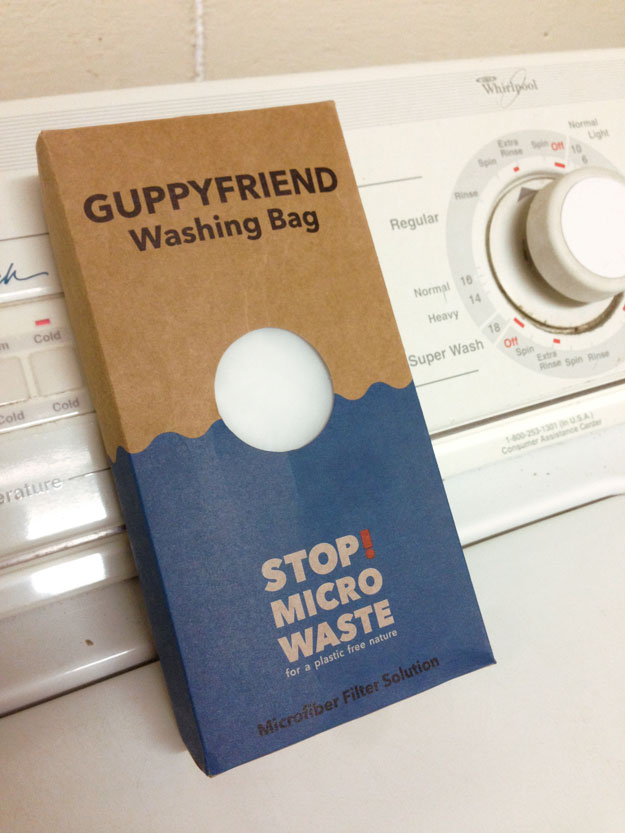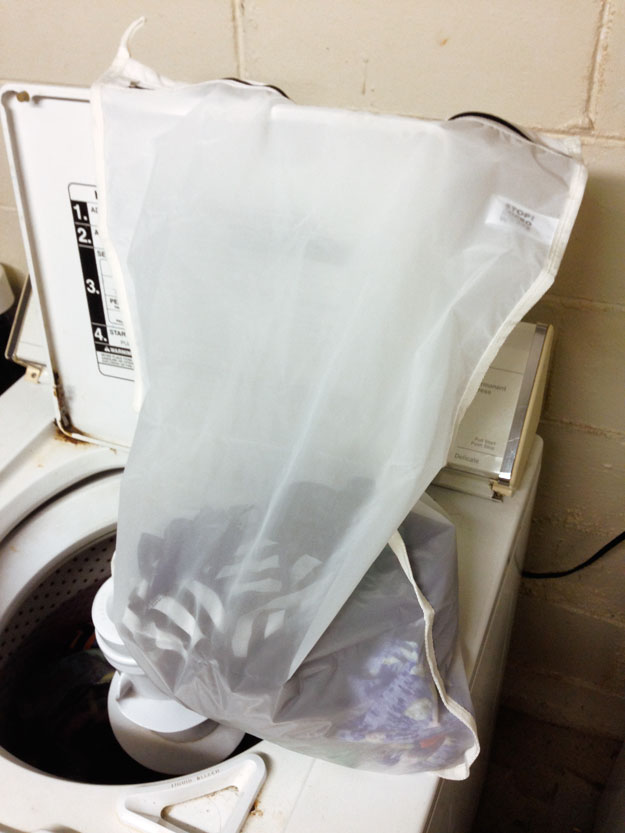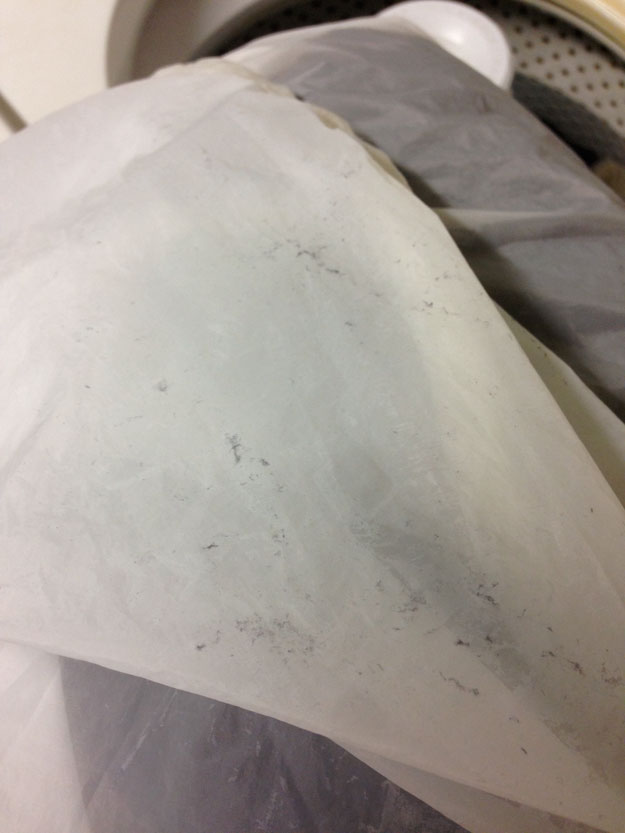A few months ago I posted about the issue of synthetic microfibers being released from our laundry into waterways, where they accumulate and cause environmental problems. While re-engineering modern fabrics is the best long-term solution to this problem, as a proponent of secondhand clothing and making items last as long as possible, I wanted to do something to mitigate the pollution caused by my existing wardrobe.

Enter the Guppyfriend washing bag. The bag, created by German nonprofit organization STOP! MICRO WASTE, claims to contain microfibers released during washing so you can dispose of them in the trash rather than through the pipes. I purchased my bag through Patagonia, who sells them at cost as part of their microfiber pollution campaign.
Using the Guppyfriend is pretty straightforward. First, I sorted my clothing made of synthetic fabric and placed it in the bag. I sorted out my polyester, rayon and acrylic garments. For blended fabrics, I put it in the bag if the percentage of synthetic fibers was more than 40 percent.
One complaint I have about the Guppyfriend is that it doesn’t come with a list of synthetic fibers, leaving it up to the user to determine which fibers to put in the bag. This caused confusion for me about what to do with modal fabric, and about whether spandex sheds microfibers or not.

The Guppyfriend instructions say not to fill the bag more than half full so clothing can move around in the wash. The bag is pretty large, so I’ve been able to fit all of my synthetic garments from each load into the bag without exceeding the general halfway point. I estimate that I can get about 10 garments into the bag per load, give or take a few depending on their bulkiness.
Once the bag is full, I put it in the washing machine with the rest of the load and washed as usual. After the wash cycle, it was clear that the bag had indeed captured some microfibers:

The microfibers are easiest to see after washing darks; I can’t really see them after washing lights. I also realized that some of the fibers visible on the bag are actually on the outside—they’re fibers released by the natural textiles that weren’t in the bag. But there are still visible fibers inside the bag as well. In terms of laundry effectiveness, my clothes seem to have gotten just as clean inside the bag as they did outside of it.
I usually wash two loads right in a row, and I’ve found no problems with loading garments into the bag once it’s already wet. When I’m all done, I hang the bag to dry for next time.
One thing I haven’t totally figured out yet is how to remove the microfibers from the bag. According to the Guppyfriend FAQs, the microfibers will eventually collect in the seams and corners of the bag, where they are easier to remove. I’ve used the bag five or six times and haven’t seen much accumulation around the edges yet. Apparently this is an observation a lot of users have had, because there’s an FAQ response for this as well, pointing out that the fibers are indeed microfibers and some are transparent, making them hard to see. The bag is also designed to cushion the mechanical forces of the washing process, thereby reducing the amount of fibers shed by garments in the first place.
The bag itself is made of polyamide, which the Guppyfriend website says is fully recyclable. It requests that users mail back their bags at the end of their useful life so they can be recycled into new bags.
A second complaint I have about the Guppyfriend is that even though its material construction is addressed in great detail, there’s no information on the website and minimal information on the product packaging about how and where the bags are produced. The back of the packaging simply states: “Product of Switzerland. Sewn in Portugal.” I’ve found with moderate consistency that eco-friendly products often neglect to discuss the social aspect of their production, which to me is surprising and disappointing, since in my mind environmental and social issues go hand-in-hand.
Overall, I think the Guppyfriend is a valid interim solution for stemming the tide of microfiber pollution, and I plan to continue using mine. In addition to using the Guppyfriend, STOP! MICRO WASTE recommends the following other ways to mitigate microfiber pollution, most of which I was already doing:
- Wash in cold water
- Use liquid detergent as opposed to powder
- Wash less often
- Purchase clothing made of natural fibers
Have you tried the Guppyfriend, or any other methods of reducing microfiber pollution? How has your experience been?

Thanks for writing this! I was considering purchasing this bag.
Also, can’t agree hard enough with this:
“I’ve found with moderate consistency that eco-friendly products often neglect to discuss the social aspect of their production, which to me is surprising and disappointing, since in my mind environmental and social issues go hand-in-hand.”
Keep up the good work here. :)
I am still having a problem with what to do with the crud that comes off onto the Guppy Bag. Is there a place to recycle this stuff? I am not willing to contribute to the landfill problem……The solution is to stop buying and using such clothing but that is pretty hard to do and definitely realistic only to those whose incomes will allow linens, bamboo , silk, cotton…. Help!
I’m not familiar with any recycling programs for microfibers at this time. :( I put my Guppy Friend crud in the trash. I agree that phasing out synthetics is hard, especially if you buy only secondhand clothing like I do!
I would think the crud [microfibers] that comes off the bag would go into the “soft plastics” in the recycling chain. So maybe gather them into a larger bag to add to the RedCycle recycling bin at your local supermarket.
I bought the Guppy Friend recently. I haven’t used it yet, but I am hopeful that it’ll help with the microfiber problem.
It would be interesting to compare the accumulation in the Guppyfriend bag vs. the Cora Ball which also collects synthetic fibers.
Apparently, coral all’s coolest about 26% whilst guppy bags collect at least 70%.
Sorry, that should read: coraballs collect…!
I actually use both of these when I do laundry. I totally forgot that the guppy bag says to only fill half way so clothing can move around. I always have filled it to full without stuffing it in level and my clothes are clean and I have begun to see what looks like lint in the corners of the bag build up after a time. I put in all my clothes, no matter the fiber content because all fibers shed.
I use the Cora ball when washing my bedding as that all is too big for the guppy bags-even for the large bag size! I have seen a buildup of lint fibers as well in the Cora ball so I’m glad to see it works! I wonder if it traps the same amount of fibers like the bags do so hopefully it does!
Microfibres from synthetic fabrics cannot be recycled yet. Also, the advice on washing includes using a front loader if possible, avoid delicate washes for synthetics ( twice as much water, and more microfibres released), cold wash, and full wash.
I would think the crud [microfibers] that comes off the bag would go into the “soft plastics” in the recycling chain. So maybe gather them into a larger bag to add to the RedCycle recycling bin at your local supermarket.
That could be — however, to avoid potentially contaminating other plastics, I would check with your local program before attempting to recycle the microfibers. As recycling facilities like to say: When in doubt, throw it out!
I have ha a Guppy bag for approximately 18 months. It works very well at catching fibres however the zip started to fail about 6 months ago, the pull tag fell off and now the zip has completely failed. Considering the price I would have expected it to last at least a couple of years.
If the crud goes to landfill, surely it will leech out from there into the environment. So we are just changing the route. I try to wear only natural fibres, originally because synthetics make me itch, but lately because of our need to drastically reduce our plastic consumption.
Why not just use a cotton produce bag? Cotton is porous, and the sudsy water in your washer will seep through the bag, and wash the clothes inside the bag, right? Isn’t the the cotton tightly woven enough to trap microfibers inside? I don’t get the logic behind using a mesh bag made of polyester to put your polyester clothes inside.
I’m wondering that too. I think it might not catch all the plastic fibers. Meanwhile, this bag is good for keeping together because of the structure of the materials.
Not 100% sure though.
I was thinking that too! Or a pillowcase?
Guppy bags are made in China.
I put all of my non-recyclable plastic in a bottle brick. I use glass sauce jars instead of soda liters. It’s lasted me about 5 months now and I can still fit plastic in it. Not sure what I’m gonna do with it though hahaha. Hoping it just keeps lasting me. I’ll probably just store it somewhere since they don’t accumulate quickly.
I have had a guppy bag for just two years and lost the zipper pull annoyingly sometime ago, I noticed today that the zip is now going, the bag also has a tiny hole so time for a new one. I don’t find I get much microfibre waste at all when I wash mine occasionally enough in the corners to remove and bin. Main problem I find is that with 3 large men in the household theres’ a lot of sythetic fleeces etc to wash and I need a super large guppy bag to cope with it all, trying to get more bamboo clothing now, and I have heard that viscose is OK???
This is a good idea but I wouldn’t recommend it for very dirty clothes simply because anything fine enough to filter out micro plastics is going to keep a whole lot of what you don’t want on your clothes in that bag too. Hopefully that will just stick to the sides of the bag and not on your clothes but there is that opportunity.
I think a more effective solution would wrapt the bag or devise a filter out of the material and place it at the end of the washing machine drain hose?
That assumes you have your own washing machine and can do that but for those who can’t or use a laundromat I understand this is the next best thing.
I was thinking that too! Or a pillowcase?
You might want to check the Guppyfriend website again for their instructions on “recycling the bag.” They DO NOT recommend returning the bag to them, considering the environmental impact of transporting it back. They recommend you recycle it in your own neighborhood, after removing the zipper.